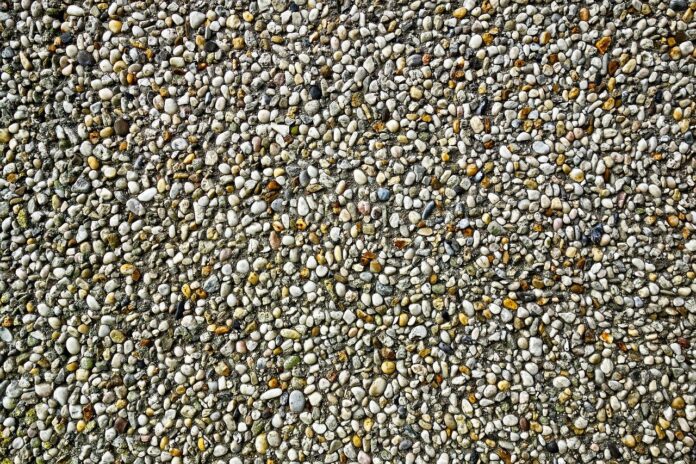Gravel stone
Choosing the proper rock or gravel for outdoor landscaping might not be easy. You’ll need to consider various factors, such as the rock’s utility for the purpose, its potential to create an attractively beautiful setting, and any harmful effects it will have on your ground or plants. It’s also worth thinking about whether you’ll need even more than one kind of rock. For illustration, the smashed marble you wish to use for your sidewalk may be ideal for a walkway but completely incorrect for use in a plant pot to reduce weeds because it will alter soil pH levels.
So, before rushing out and getting the lowest or most large rock or gravel, take some time to learn about the benefits and drawbacks of each option. Here’s a chronological selection of the top stone and gravel kinds for landscape, along with a quick discussion of how they’re typically used or the benefits and drawbacks of each.
Gathering pebbles from the beach
Pebbles on the beach are often black or dark grey, spherical, and smooth like river rocks. They’re most commonly utilized as an ornamental stone in a wide range of plants, around plants in a grow bed, and in the gaps between larger pebbles or boulders. They are pricey, even though they are widely available in garden supply stores. As a result, they’re often available in small bags and aren’t frequently utilized to cover huge regions. There are instances, and if you already have the funds available, you can take advantage of them.
Landscaping gravel is a type of material used in outdoor gardens, driveways, and paths to enhance outdoor spaces’ aesthetic appeal and functionality. Various types of gravel are available, each with its unique color, texture, and size, making it possible to choose the perfect type for a specific landscaping project. Some of the most popular types of gravel include pea gravel, crushed stone, river rock, and decorative stone.
Pea gravel is small and rounded, making it a great option for garden paths and beds. Crushed stone is a more affordable option and is often used as a base material for driveways and retaining walls. River rock is larger and more decorative, ideal for water features and rock gardens.
Decorative stone is available in various colors and textures, making it a great option for adding a touch of elegance to a landscape. When choosing a type of gravel landscaping, it is important to consider the desired look and function of the area and factors such as maintenance, cost, and durability.
Landscaping Gravel Types
Boulders
In beautifully landscaped, stones and other huge rocks are frequently utilized as feature rocks. When used in the correct setting, they may be rather striking, and there are a few things to keep in mind.
To begin, if you want to restore the natural lawn, you should hunt for rocks that are local to the area. It’s also crucial to embed the jewel in the earth; boulders don’t generally sit on top of the substrate in nature. You might also want to explore grouping stones of various sizes together, as one boulder standing alone can look out of place. Boulders could be a terrific complement to your landscape, but they won’t happen throughout every garden, so plan. Understand that stones are typically costly, and they’re also enormous, heavy things that might be difficult to install, which can drive up the price even higher.
Read More: Best Steps To Cleaning Mouse Pad And Some Interesting Fun Facts About This
Chips of bricks
While not strictly a type of rock, brickwork chips, which seem to be small fragments of crushed building bricks, will be used as paving aggregate in the very same way as stones and gravel can be. Brick chips offer two primary advantages over all igneous rocks: affordability and color availability. Several granite countertops are more expensive than old shattered bricks. People are sometimes determined to give these away since disposing of heavy, discarded construction activities are costly. So, if you want to save cash on your landscaping job and are ready to put in a little elbow grease with a hammer, brick chips would be a good option.
Variety of chips
Similarly, bricks come in various hues that aren’t found in many natural sources of stones. Utilizing genuine brick chips is one method to ensure that you get the color right if you would like an 1960s redbrick-colored roadway and a a1970s yellow brick path. But keep in mind that brick chips aren’t appropriate for every landscaping project, and if utilized incorrectly, they could be more hassle than they’re worth. As a result, this is a product that you really should carefully investigate, and most experienced landscapers recommend avoiding it when you can purchase natural stone gravel.
Smashed granite
Crushed granite sand is a gorgeous, affordable, and damn difficult material that is well worth exploring for lining a footpath, improving the aesthetics and permeability of your carport, or defining a garden area.
Crushed granite pebbles drain effectively because they contain bigger particles than degraded granite. It’s also an excellent paving product for projects that involve a big area to be covered or where puddling must be prevented. It usually comes in a white and grey tint with a gentle, natural aspect. Still, it may also be obtained in earthy brownish or tan hues that integrate nicely with a landscape that demands a natural aesthetic.
Decomposed granite
Desiccated granite has a texture similar to gravel but is considerably finer and just about sandy. It is made of hard igneous rock that has been weathered and eroded naturally, and it has long been used in the design concept. Decayed granite is commonly used to cover walkways, driveways, and other open spaces such as terraces and can also be used as a hardwood mulch surrounding trees and raised beds. Although it comes in various colors, it’s usually grey, from reddish tan to brown, just like finely ground gravel.
Use of flagstone
Flagstone is an excellent substitute for cement or professionally made pavers. It has historically been used to produce roof tiles, blocks, fences, and even gravestones, which can generate a variety of challenging surfaces, such as roads, patios, and landscaped paths. Flagstone will attract consumers who want their landscape to have a natural, earthy aspect. While flagstone is a particular form of sandstone, many other massive stone substances, such as slate, limestone, gypsum, sandstone, and natural stone, can be utilized in much the same fashion.
Use of lava rock
Lava rock is an ornamental rock made up of small bits of hardened lava from an eruption. It is being used as a substitute for wood waste. It is not ideal for use on roadways, walks, or patios due to its brittleness, but it can add color and clarity to a route around large concrete or granite represented in the form. Lava rock, which appears in different colored tones, can also be used as a low elevation cover for wide-open areas that would otherwise be dobbed. It’s crucial to use an excellent architectural fabric and border to hold the lava stone in line if you’re going to use it this way.
Conclusion
There are many types of landscaping gravel, so choosing the right one can be challenging. Several factors need to be considered, including how functional the stone or material is for the task at hand, how aesthetically pleasing it is, and whether or not it is harmful to your soil or plants.
Frequently Asked Questions
- Is it easy to set the landscaping with gravel material?
Yes, it is not a difficult job.
- Which marble is best for landscaping?
All the marbles which are mentioned above are best. But it depends on your choice.










